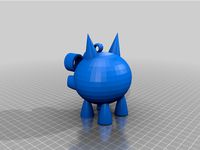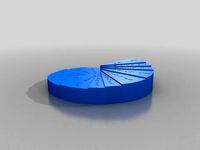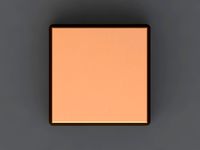Thingiverse

Punnett Square by collegeofthedesert
by Thingiverse
Last crawled date: 3 years, 1 month ago
The Punnett square is a square diagram that is used to predict an outcome of a particular cross or breeding experiment. It is named after Reginald C. Punnett, who devised the approach. The diagram is used by biologists to determine the probability of an offspring having a particular genotype. The Punnett square is a tabular summary of possible combinations of maternal alleles with paternal alleles.[1] These tables can be used to examine the genotypical outcome probabilities of the offspring of a single trait (allele), or when crossing multiple traits from the parents. The Punnett Square is a visual representation of Mendelian inheritance. It is important to understand the terms "heterozygous", "homozygous", "double heterozygote" (or homozygote), "dominant allele" and "recessive allele" when using the Punnett square method. For multiple traits, using the "forked-line method" is typically much easier than the Punnett square. Phenotypes may be predicted with at least better-than-chance accuracy using a Punnett square, but the phenotype that may appear in the presence of a given genotype can in some instances be influenced by many other factors, as when polygenic inheritance and/or epigenetics are at work.
Similar models
thingiverse
free

Punnet Square with Braille and Game by collegeofthedesert
... (“aa” and “aa” have the dominant allele expressed, and “aa” is homozygous recessive and does not have dominant allele expressed)
3dwarehouse
free

Genotype Dihybrid Cross
...or thing. any constructive critisicm would be appreciated. #allele #father #genetics #genotype #goldenfrog #mother #punnet_square
grabcad
free

P-Square
...wers or the traits passed down being placed in the empty boxes correlating to the traits. the product is 62 x 62 x 13 cm in size.
thingiverse
free

Dihybrid Cross Punnett Square by demitrariel
...uct a dihybrid cross. i created this for a visually impaired student to understand the chart diagram that students typically use.
thingiverse
free

Dragon Genetics by mfritz
...de. the two pieces are then glued together.
the models are thick enough to stand on their own without gluing on the reverse side.
grabcad
free

Square landscape styling in 2023
...scape styling in 2023,
important: who can use the creo drawing method to add the word "福" to the sphere of the lantern.
grabcad
free

Square landscape landscape in 2023
...ape landscape in 2023,
important: who can use the creo drawing method to add the word "福" to the sphere of the lantern.
thingiverse
free

One Sided Dice by sevgonlernassau
...igged. 100% guaranteed one outcome. a better predictor than nate silver or prediction markets. the rngesus will always favor you.
thingiverse
free

Alien Baby
... they will create them in tynker. they will have to make sure the proponents are correct to successfully 3d print the alien baby.
thingiverse
free

Beefier Cable Clip by KhakiSlurry
...th 2 layers on shell. printing solid is probably fine too. the part is somewhat hollow at 50% and may have greater flexibility.
Punnett
thingiverse
free

Dihybrid Cross Punnett Square by demitrariel
...uct a dihybrid cross. i created this for a visually impaired student to understand the chart diagram that students typically use.
thingiverse
free

Punnet Square with Braille and Game by collegeofthedesert
...braille and game by collegeofthedesert thingiverse this is a punnett square. the files are broken up to do dual...
grabcad
free

P-Square
...by fri-007 from ti-40-01, the product is a real-life punnett square, a teaching aid which is used in the...
3dwarehouse
free

1910 Punnett Cycle Company 'sociable' Tandem
...1910 punnett cycle company 'sociable' tandem
3dwarehouse
side by side tandem #bicycle #tandem
Collegeofthedesert
thingiverse
free

CWSC by collegeofthedesert
...cwsc by collegeofthedesert
thingiverse
cwsc
thingiverse
free

Unit Circle with Braille by collegeofthedesert
...t circle with braille by collegeofthedesert
thingiverse
this model was created by one of tutors after tutoring a blind student.
thingiverse
free

Punnet Square with Braille and Game by collegeofthedesert
... (“aa” and “aa” have the dominant allele expressed, and “aa” is homozygous recessive and does not have dominant allele expressed)
thingiverse
free

Rubik's Cube Braille Tiles by collegeofthedesert
... adhesive. all filament was matterhacker abs pro which printed great and should hold up to the high temperatures of where i live.
Square
turbosquid
free

Square
...squid
free 3d model square for download as max, obj, and stl on turbosquid: 3d models for games, architecture, videos. (1510355)
3d_export
$5

square table
...square table
3dexport
square table
turbosquid
$12

Square
...oyalty free 3d model square for download as max, obj, and fbx on turbosquid: 3d models for games, architecture, videos. (1294110)
3ddd
$1

Square Ottoman
...square ottoman
3ddd
пуф
square ottoman
turbosquid
$25

The Square
...ee 3d model the square for download as mat, max, dxf, and obj on turbosquid: 3d models for games, architecture, videos. (1186399)
3d_export
$65

square
...square
3dexport
simple rendering of the scene file
3d_export
$65

square
...square
3dexport
simple rendering of the scene file
3d_export
$65

square
...square
3dexport
simple rendering of the scene file
3d_export
$65

square
...square
3dexport
simple rendering of the scene file
3d_export
$65

square
...square
3dexport
simple rendering of the scene file
